Black spiders are often associated with venomous spiders. Not all black spiders are venomous and even those that carry venom can sometimes have a non-aggressive nature.
Black spiders can be identified by their looks. They can have an all-black body or a black body with colored markings.
These spiders have 8 legs which can also be black or black with colored markings or stripes.
Table of Contents
Are black spiders poisonous?
Not all black spiders are poisonous.
The Black Widow is often seen as the most dangerous black spider. Its bite is painful and its venom is dangerous, albeit not lethal.
Black House spiders are also venomous. Their bite can be painful and it can result in irritation or skin rashes in the area of the bite. However, these spiders aren’t considered dangerous as they rarely bite.
Types of black spiders
Black spiders can be categorized by species.
Most black spiders are found in the families of wolf spiders, fishing spiders, Black Widows, jumping spiders, cupboard spiders, parson spiders, and trapdoor spiders. Some tarantulas are also blac.
1. Tigrosa georgicola

Some individuals of the Tigrosa georgicola are known for their mostly black bodies. They have a black and brown body with patterns resembling those seen on tigers.
These spiders live in solitude and they don’t spin webs. Excellent eyesight characterizes them, together with most other Wolf spiders. While not particularly dangerous, they can inject venom when biting.
2. Carolina Wolf Spider

The Carolina Wolf Spider (Hogna carolinensis) is one of the largest wolf spiders in the US. It is known for having a distinct look from males to females.
Male Carolina Wolf spiders are known for a gray body color with a black underside. The females can exhibit all-black bodies with black legs.
The females are also larger than males. They can grow up to 35 compared to a maximum body size of 20mm for males.
3. Woodland Giant Wolf Spider
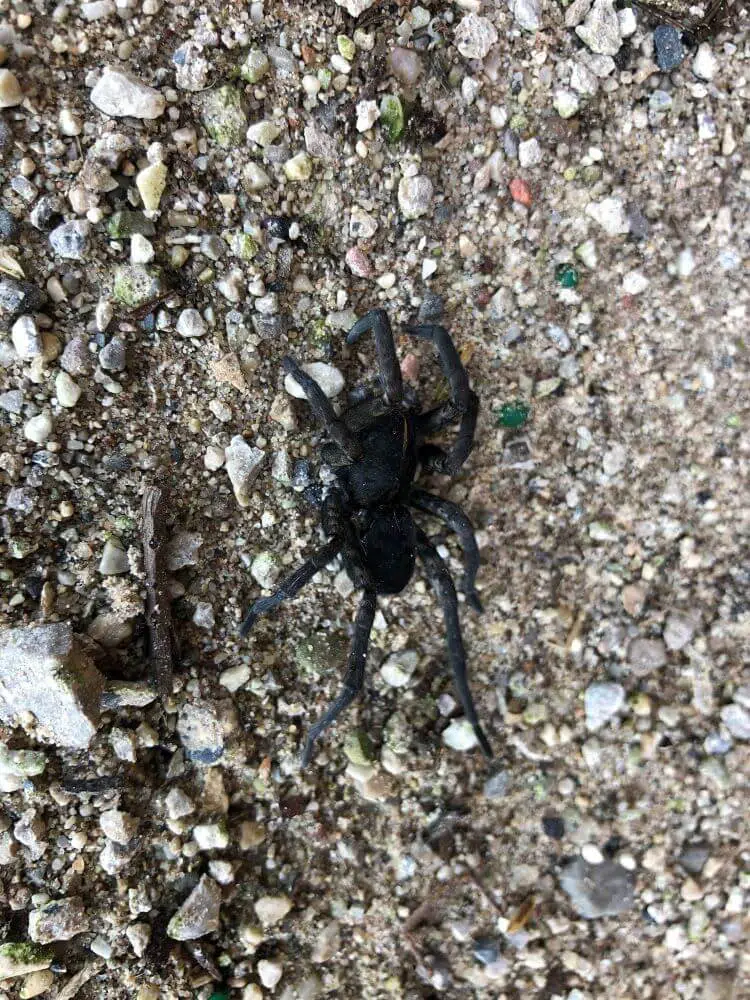
As one of the largest species of Wolf spiders, the Woodland Giant Wolf Spider (Tigrosa aspersa) can reach a size of up to 25mm.
This species is known for having a mostly black thorax, a black head, and a black abdomen. Yellow markings can sometimes be distinguished on the body of the spider.
Its legs are mostly yellow-brown with black markings. Its tiger-like physical appearance prompted this species to be re-categorized from Hogna aspersa to the Tigrosa family.
4. Funeral Wolf Spider

Commonly seen in the US from May onwards, the Funeral Wolf Spider (Allocosa funerea) gets its name from its dark-colored body.
It has a black head and a shiny black thorax. The abdomen is not shiny and it’s only partially black as it also exhibits brown hairs.
The legs of the spider are translucent with brown and black coloring.
5. Noble False Widow

The Noble False Widow (Steatoda nobilis) is often wrongly identified as a true Black Widow. It can bite, but its bite doesn’t result in more than local pain or swelling.
Noble False Widows aren’t completely black like true Black Widows. Instead, they have a brown body with black marks. Its legs are mostly brown and shiny.
This spider can further be identified by its bulbous body. Its abdomen has a round bulbous dome shape.
6. False Black Widow

False Black Widows (Steatoda grossa) generally have different colors from light brown to dark brown or even black. These species resemble true Black Widows in size as they grow around 10mm in body size.
However, many False Black Widows have a dark brown to the black body. These spiders also have markings on the abdomen (not hourglass markings) but they are generally difficult to see as the abdomen can sometimes be black while the markings are dark brown.
7. Boreal Combfoot

This cobweb spider (Steatoda borealis) is recognized by its dark brown and black body. They also have a white stripe on the abdomen.
Spiders of the Boreal Combfoot species are known to have darker bodies closer to the head, particularly on the thorax and upper part of the abdomen. The lower part of the abdomen is mostly dark brown.
Its legs are also black making this spider appear almost black in certain natural habitats.
8. Eastern Parson Spider

This nocturnal species (Herpyllus ecclesiasticus) is seen on walls around the house at night. Its body is characterized by both black and red-brown coloring.
The body itself is mostly black with black hairs. This black coloring expands to part of its legs while the tips of its legs are of red-brown coloring.
Common around the house, this spider can sometimes be beneficial as it feeds on common household bugs and insects.
9. Western Parson Spider
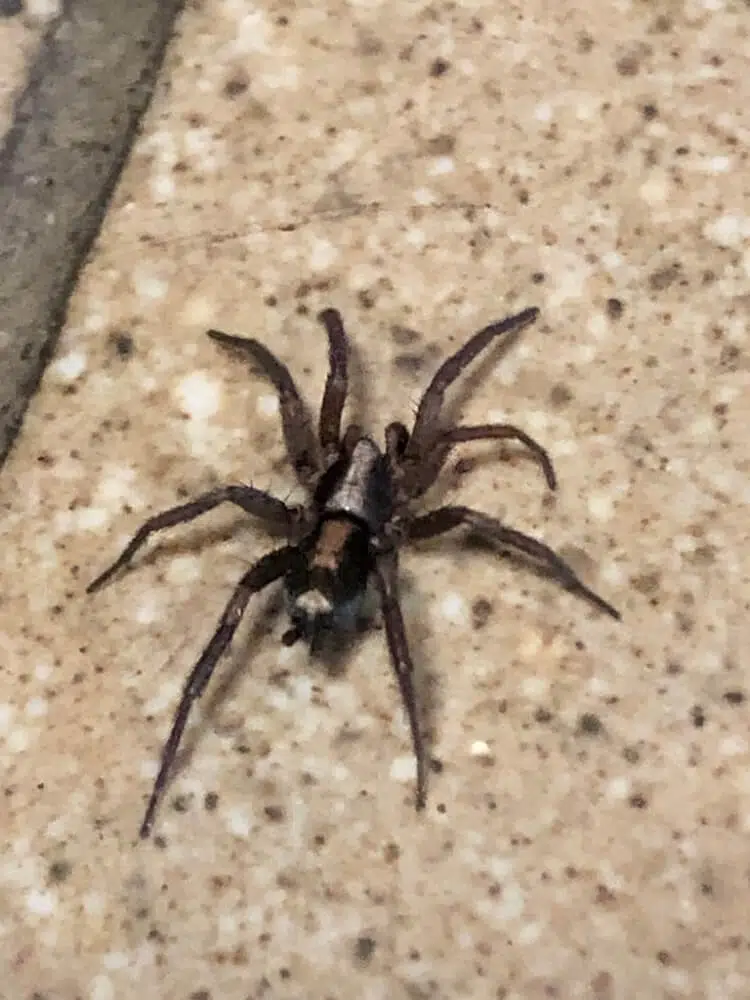
Tan, brown, and black are all common colors of the Western Parson Spider (Herpyllus propinquus). This species is known for being tricolored.
Black dominates the abdomen of the spider with some white markings. Its thorax has a red-brown color.
The rest of the body which includes the legs is of light brown or even tan coloring.
10. California Trapdoor Spider

These spiders (Bothriocyrtum californicum) are mostly seen in the fall during the mating season. Living in the ground, they have many natural predators.
However, it’s sometimes difficult to spot a California Trapdoor Spider in low light as it has a mostly black body.
Its upper body is of shiny black coloring as is its legs. Its abdomen has a tan color.
This spider has very thick black legs with short black hairs.
11. Southwestern Trapdoor Spider
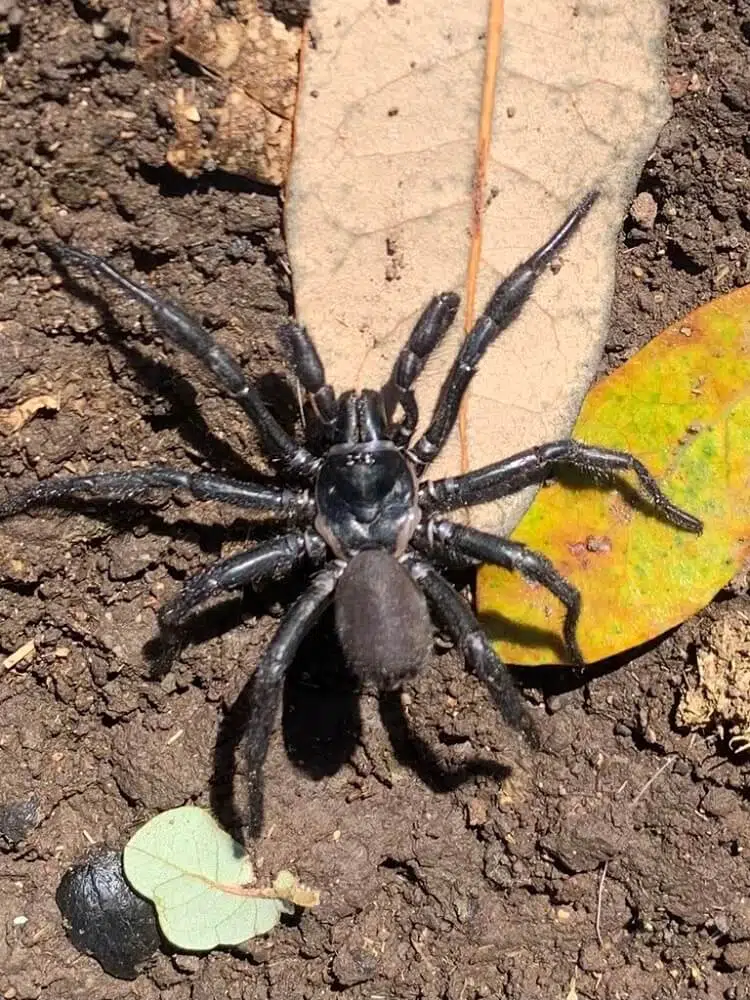
This species (Eucteniza relata) is mostly found in Southern states. It has a brown body covered in black bristles which makes it appear like a true black spider.
Like other spiders of the Euctenizidae family, it lives underground. It protects its burrows by creating a false lid at ground level. This is done using silk.
12. Audouin’s Trapdoor Spider
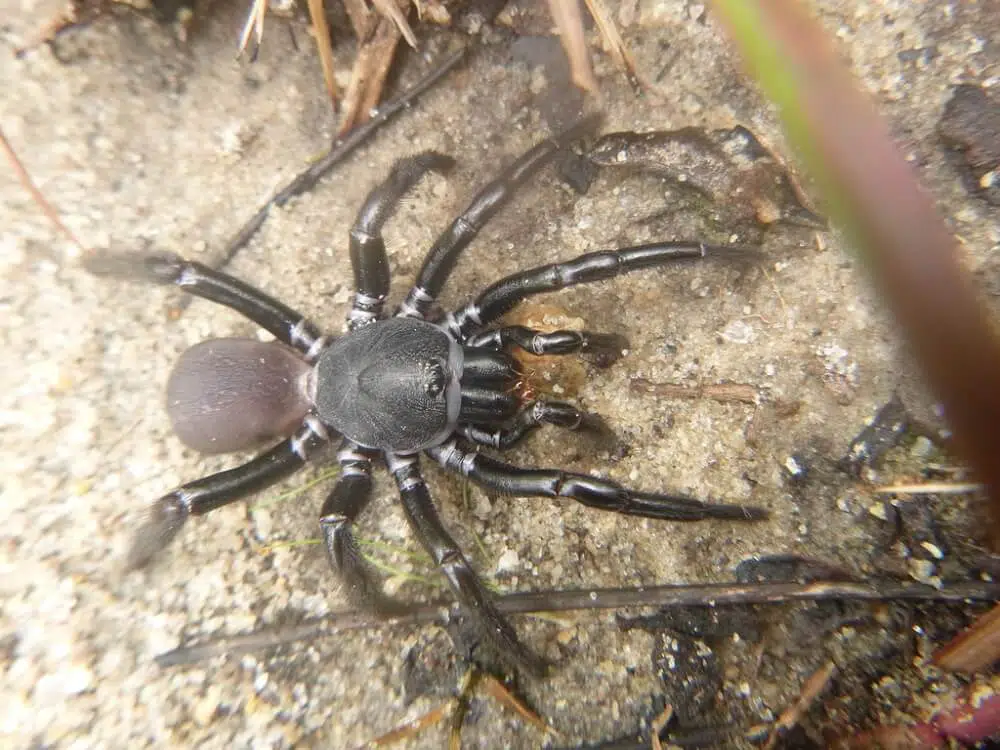
Found in Forests in the East and the South, this spider (Ummidia audouini) is almost entirely black. Its legs are shiny black while its body is black with black bristles.
Studies on the species show it’s generally harmless. While it bites when threatened, its bite comes isn’t followed by high pain specific to poisonous spiders.
13. Thevenet’s Trapdoor Spider
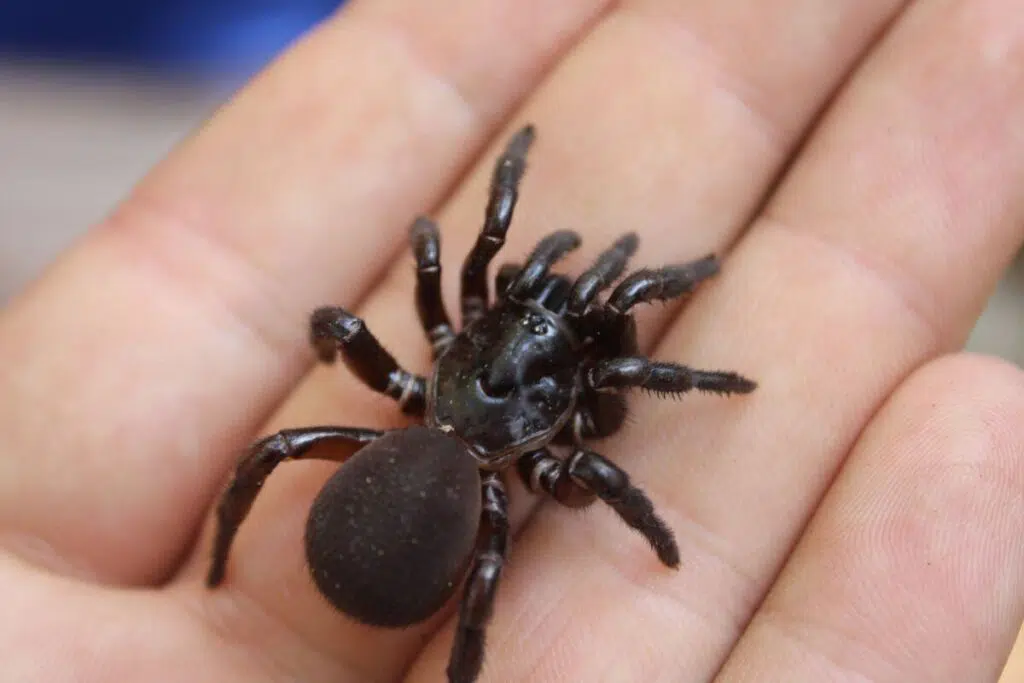
Part of the Halonoproctidae is seen in humid environments. Sometimes confused with Bothriocyrtum, this species (Hebestatis theveneti) is also mostly black.
The thorax of the spider and its legs are of shiny black coloring. Its abdomen is of brushed black appearance mostly due to the dark gray bristles.
14. California Ebony Tarantula

Known as a false tarantula, the California Ebony Tarantula (Aphonopelma eutylenum) is part of the Theraphosidae species.
This spider is known for having a multi-colored body.
Its body is thick, as are its legs. Its head, carapace, and abdomen are black. The spider also has partially black legs.
The tips of its legs are dominated by a red-brown color due to the long red-brown bristles found on its dual-color legs.
15. Texas Tan Tarantula

The Texas Tan Tarantula (Aphonopelma anax) is common in Southern states. This tarantula mostly lives in burrows.
It gets its name from its tan, brown, and black coloring.
The male Texas Tan Tarantula has larger black sections on its body with just a few tan bristles on its carapace and abdomen.
Females have a tan body with black and tan legs looking considerably different than male Texas Tan Tarantulas.
16. Steindachner’s Ebony Tarantula
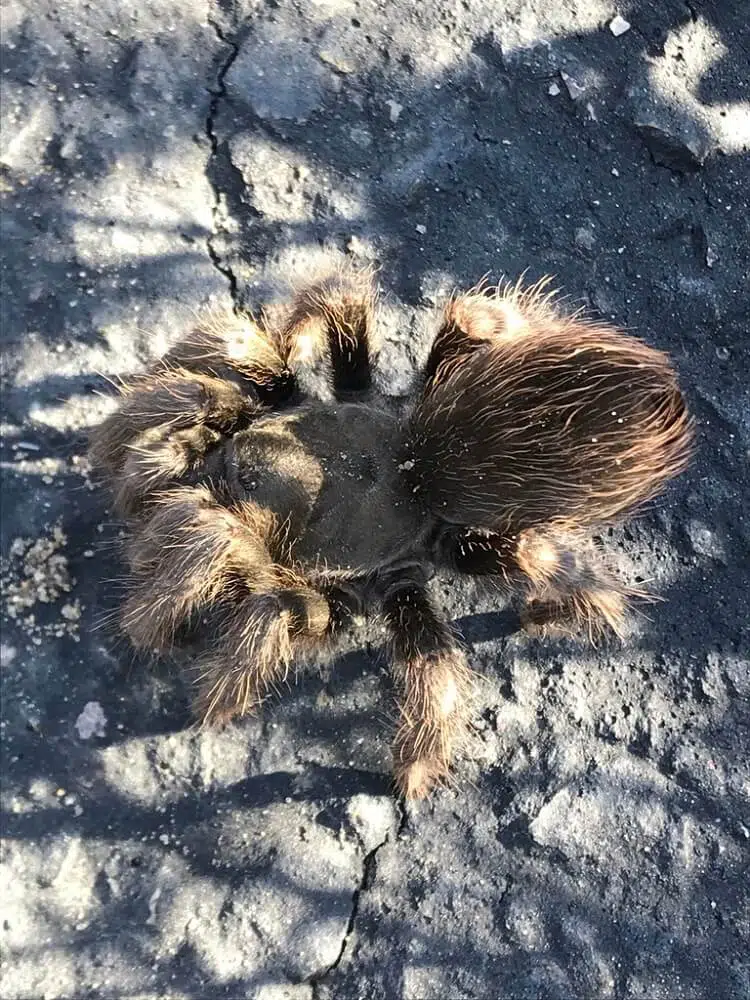
This species (Aphonopelma steindachneri) is common in the US parts of California as well as in Baja California and other parts of Mexico.
Both the female and the male are known for a mostly black body and black legs. Both have tan bristles. The female has just a few tan bristles which are barely visible.
Males have more brown bristles, particularly on the abdomen.
17. Grand Canyon Black Tarantula

This species (Aphonopelma marxi) is known to be present in the 4 corners of the country.
It’s characterized by an almost completely black body and black legs. A few orange or red hairs are sometimes distinguished on this large spider.
The female is larger than the male and it can reach a body size of up to 35mm.
18. Johnny Cash Tarantula
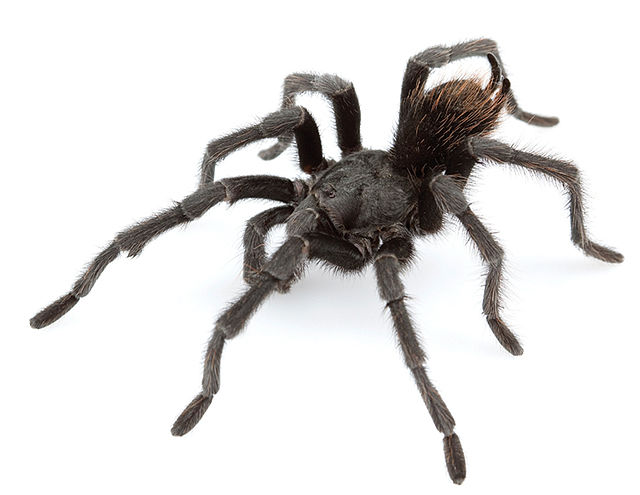
A similar species is the Johnny Cash Tarantula (Aphonopelma johnnycashi).
The female has lighter coloring compared to the male spider. Males are almost entirely black, with some bright-color hairs at the end of their abdomen.
This is a relatively new species being discovered in 2015. It was named after Johnny Cash who was an artist known as ‘The Man in Black’.
19. Tucson Bronze Tarantula
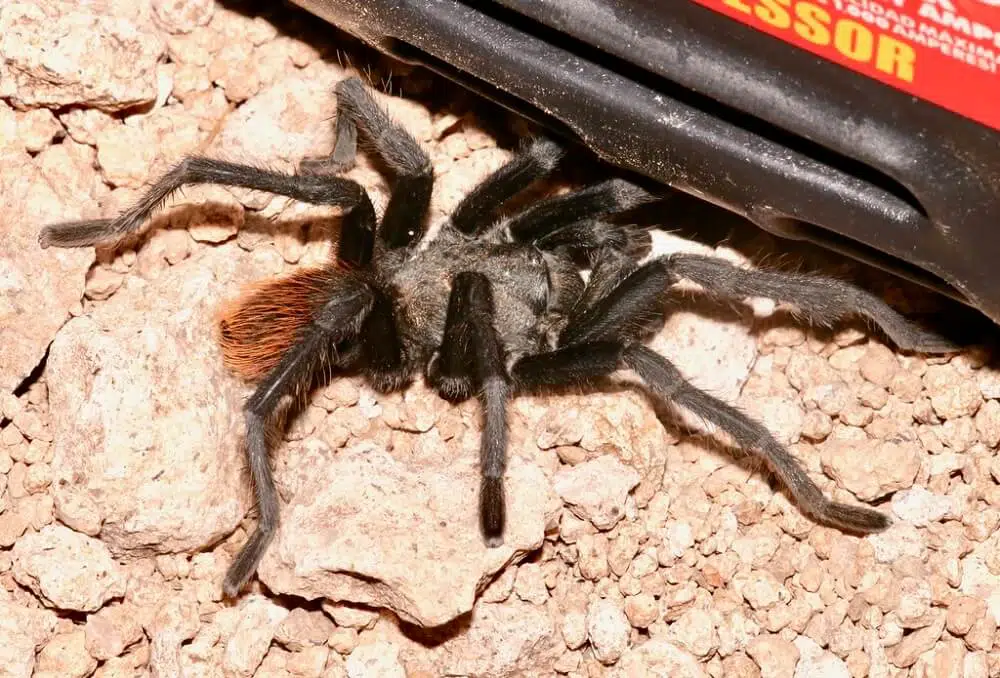
The Tucson Bronze Tarantula (Aphonopelma vorhiesi) is common in hot Southern climates. This large spider is known for its almost black body.
A black body characterizes this tarantula. Its legs are also black with black or bronze hairs. Some members of the species are also known for having bronze markings on the thorax.
20. Chiricahuan Gray Tarantula
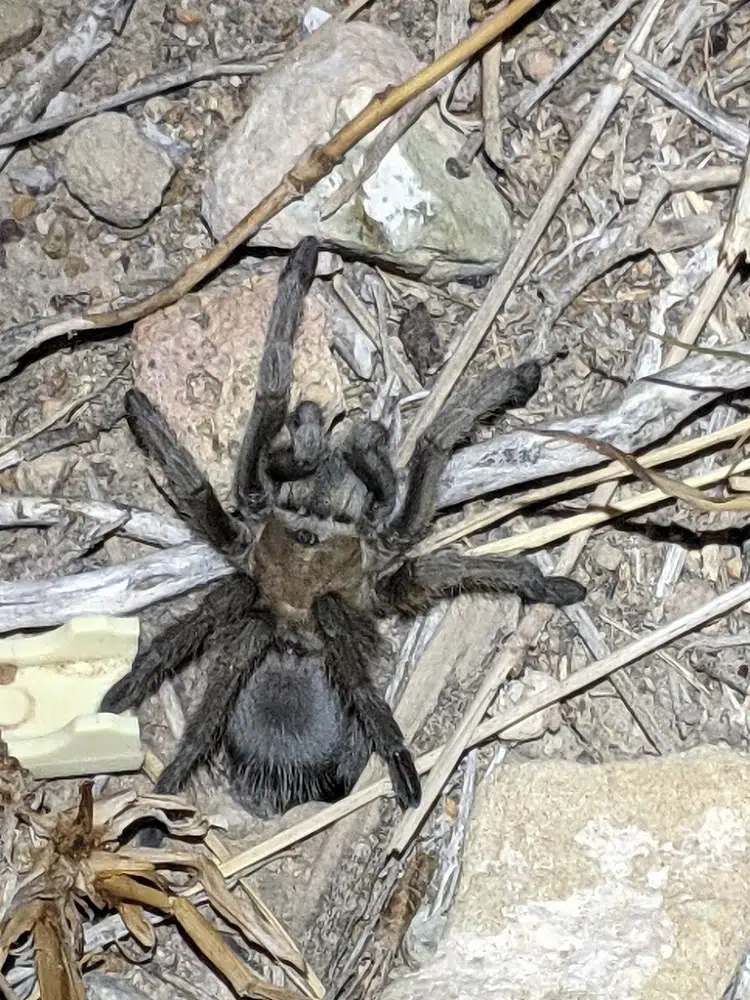
This tarantula (Aphonopelma gabeli) is known for living in burrows, like most other tarantulas. It grows to a body size between 4 and 5 inches and it’s normally of charcoal gray coloring.
However, the male of the species is rarely seen and it’s almost entirely black. A fuzzy black body characterizes the male. Its long slender legs are also black.
21. False Tarantula

The False Tarantula (Calisoga longitarsis) gets its name from resembling an actual tarantula. However, the Calisoga spider is not a real tarantula.
You can distinguish a False Tarantula from a real tarantula by the hairs on its body. A real tarantula has more black hairs that are similar to bristles. A False Tarantula has lighter silver color hairs that are softer.
22. Red-legged Purseweb Spider
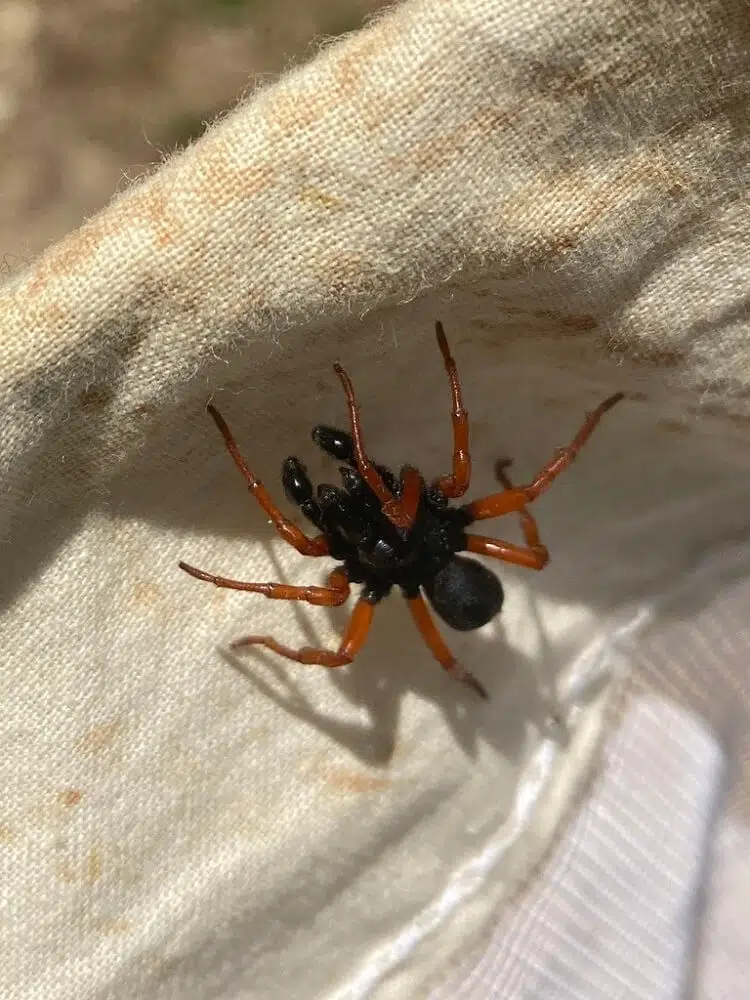
This spider (Sphodros rufipes) has fangs that point down. It has a brown body but it gets its name from its red legs.
Only the male Red-legged Pursewb Spider has red legs and a black body. The female has a black body and black legs.
The species is common in states such as Indiana and Missouri.
23. Black Purseweb Spider
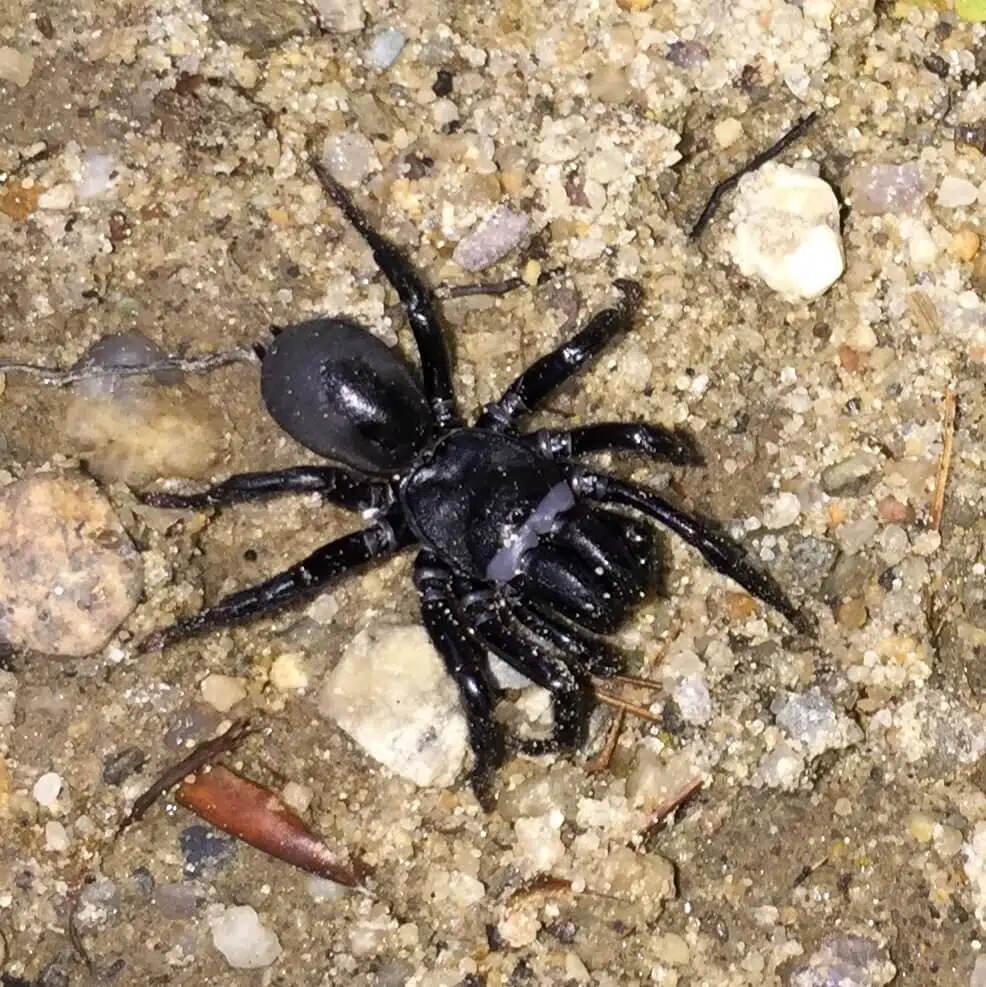
The Black Purseweb Spider (Sphodros niger) is known for creating vertical webs on trees where it hides and awaits its prey.
A deep black body color characterizes the way these spiders look. They have brown legs which have no black markings. Spiders of these species are rarely seen as they spend most days hiding in their webs.
24. Asian Spinybacked Orbweaver

This species (Thelacantha brevispina) is the sole spider of the Thelecantha genus. It has been introduced in the US through Hawaii.
The female is larger than the male with a multi-colored body. Males have a black body with white marks which is typically smaller than the body of the female.
Males grow up to 0.2 inches while females grow up to 0.4inches.
25. Southern House Spider

These spiders (Kukulcania hibernalis) are common in households. While they bite, they aren’t poisonous. Most people remove them by vacuuming.
Males and female Southern House Spider look different. Males are known for a light brown body with light brown legs.
Females have an all-black body that is shiny at the thorax and opaque at the abdomen. Its legs are also black.
26. Mouse Spider
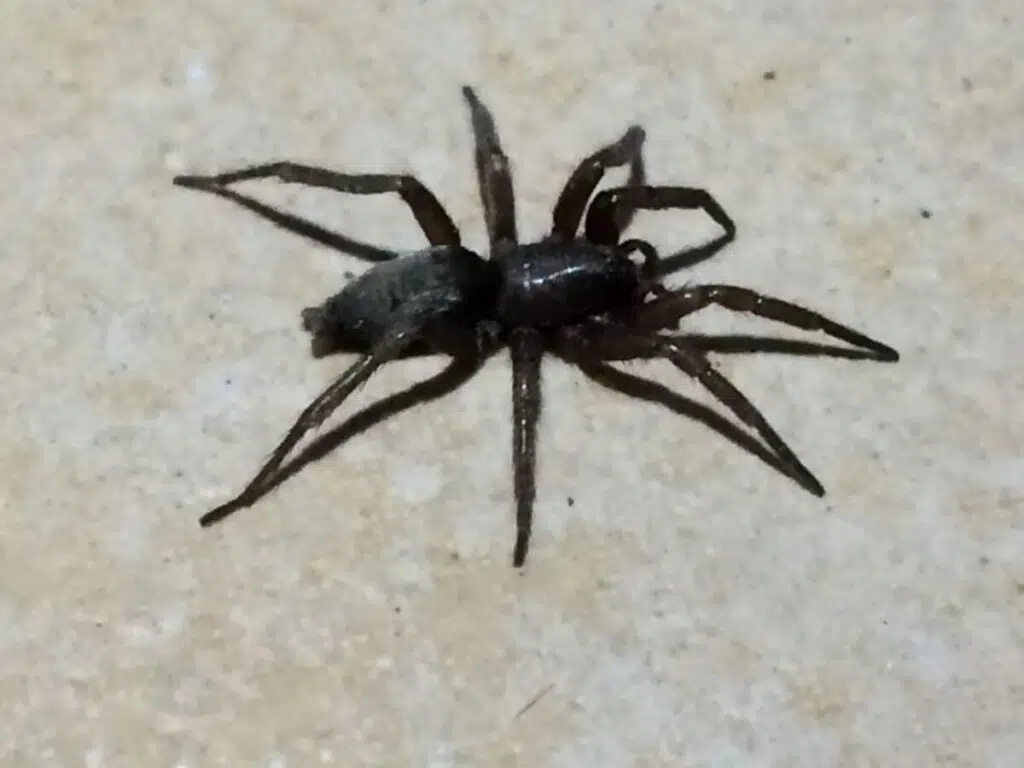
Mouse spiders (Scotophaeus blackwalli) are common on the West Coast. It’s believed these spiders made their way to North America from Europe.
They are found almost exclusively in human settlements, growing to a maximum size of 12mm.
These spiders are only partially black. They have a black abdomen while the carapace and legs are brown with brown hairs.
27. Arizona Black Hole Spider
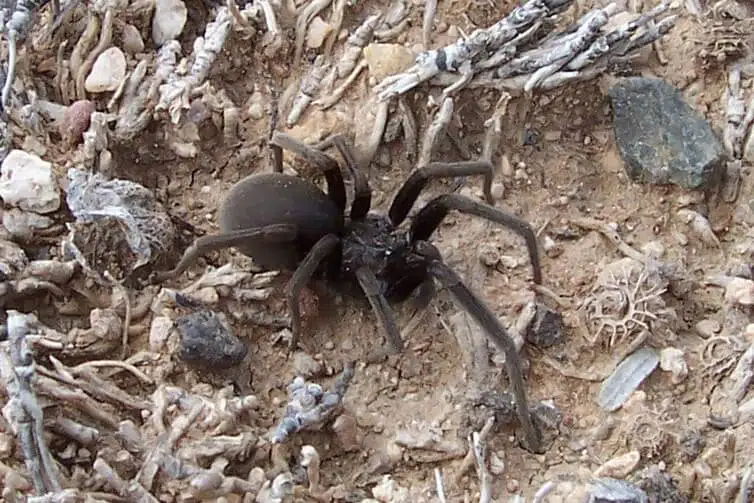
The Arizona Black Hole Spider (Kukulcania arizonica) is known for living in Arizona and neighboring states such as Nevada.
It builds silk tubes in burrows and crevices where it hides and waits to ambush its prey.
This spider is mostly black. The male appears larger than the female, but it only has longer legs. Females have a bigger body that can grow up to 13mm.
28. Black Laceweaver

The Black Laceweaver (Amaurobius ferox) is part of the Amaurobiidae family which comprises 3 spider species.
Known for its black color, this species is seen on multiple continents. Females have a dark brown to black body and brown legs.
Females also spin distinct webs which resemble wool. These are sticky webs in which flies, bugs, and other spiders get trapped easily.
It’s only males that know how to navigate the web females spin. Males enter the sticky web when mating and they spin a web of their own, mainly to see if the female is interested in mating.
29. Pacific Foldingdoor Spider
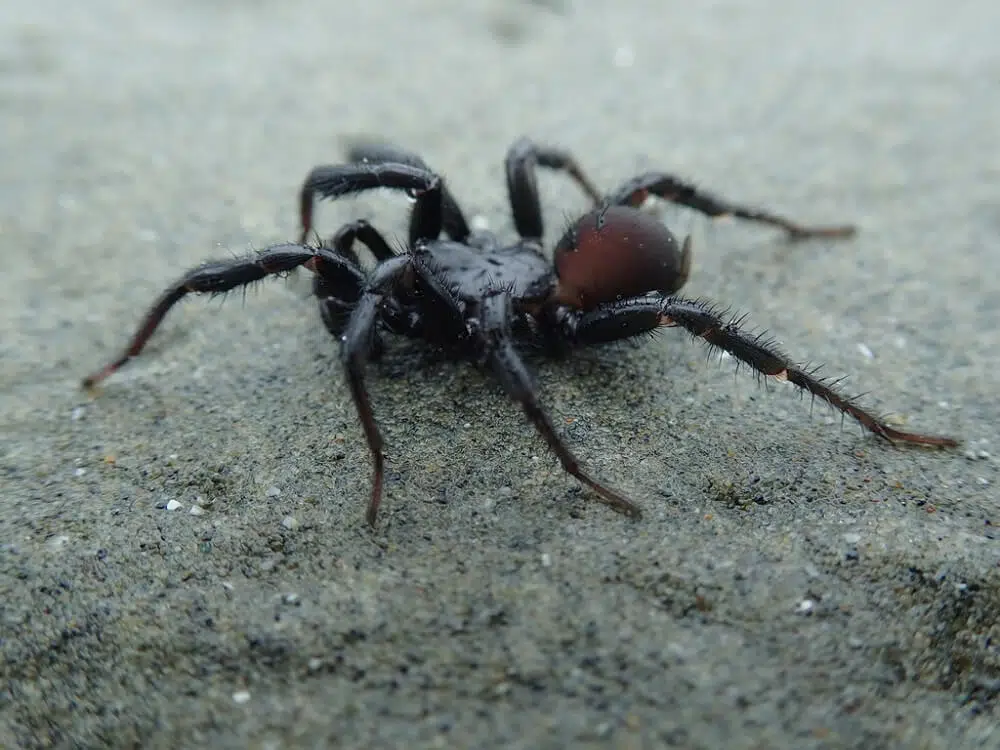
Known to live around the states on the Pacific Coast, these spiders (Antrodiaetus pacificus) grew between 0.4 and 0.5 inches.
The species is active in late summer when both males and females are commonly seen.
Spiders of the species are known for their shiny black body. These spiders also have a light brown bulbous abdomen.
Commonly found on the West Coast, these spiders can be seen everywhere from Alaska to California
30. Eastern Triangular Cobweaver

Part of the Theridiidae family, the Eastern Triangular Cobwear spider (Euryopis funebris) gets its name from the shape of its body. It has triangular abdomens which give it a rare shape.
This spider is also black. Common in North America, this black spider has silver-gray markings on its body.
It has a thick contouring line on its abdomen as well as small gray markings on its black legs. The highest chance of seeing this spider is in mid-July.
31. California Turret Spider
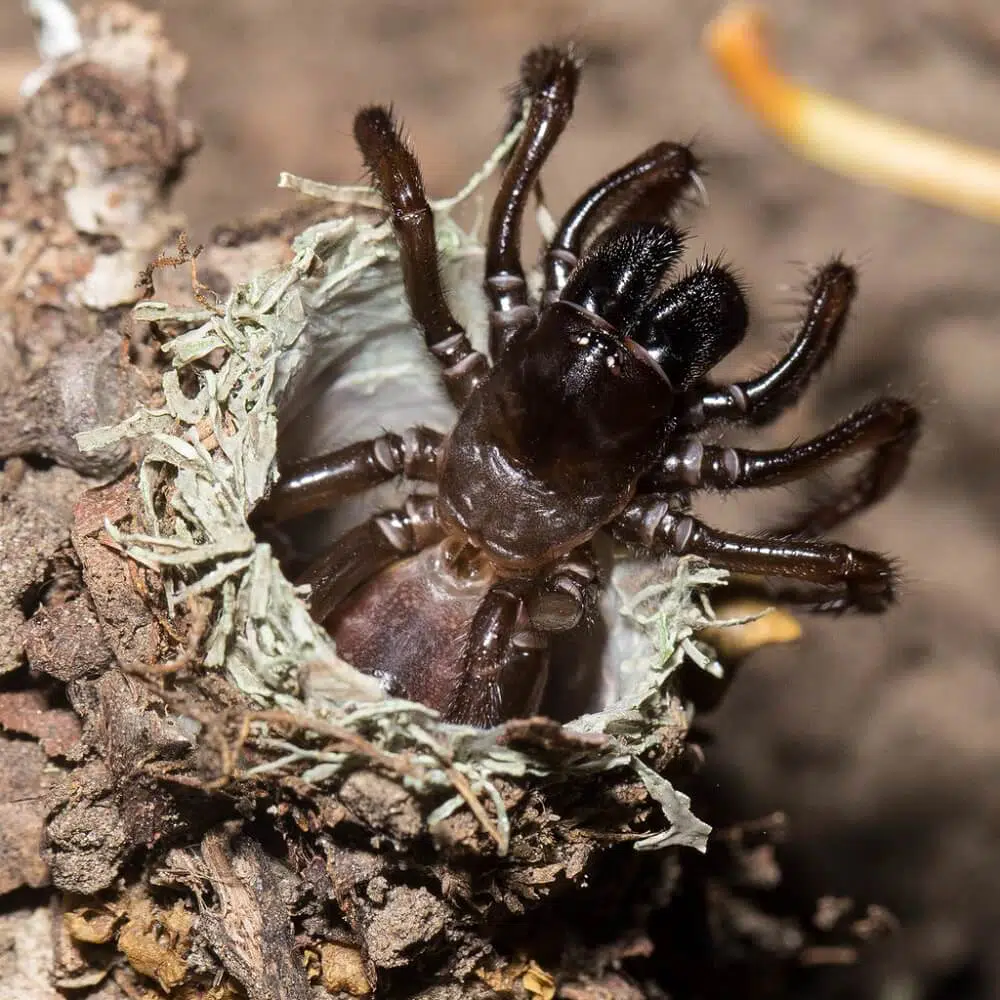
Part of the Antrodiaetidae family, this spider (Atypoides riversi) is mostly found in California like a native species.
It has been seen in various colors and color combinations. Green, brown, and black are all colors these spiders can appear in.
The spider is commonly known as a burrowing species that builds deep and wide burrows in the ground. All of these burrows are then sealed with debris which acts as a cork. Soil is used to close off its burrows.
This species has an average size. Males are smaller but females can grow up to 0.7 inches.
32. South American Toothed Hacklemesh Weaver

This species (Metaltella simoni) is common throughout North and South America. The spider has an average size with the male growing between up to 7 and 8mm while females grow up to 9mm.
Both sexes are known for having black parts on their bodies, even if these aren’t entirely black spiders.
The abdomen is typically black for both the male and the female. The rest of the body is brown. With their brown legs, these spiders move fast.
Distinctions between male and female spiders are made by a third color. It’s typically orange as male spiders have orange Chevron-shaped marks on the thorax.
33. Falconina gracilis
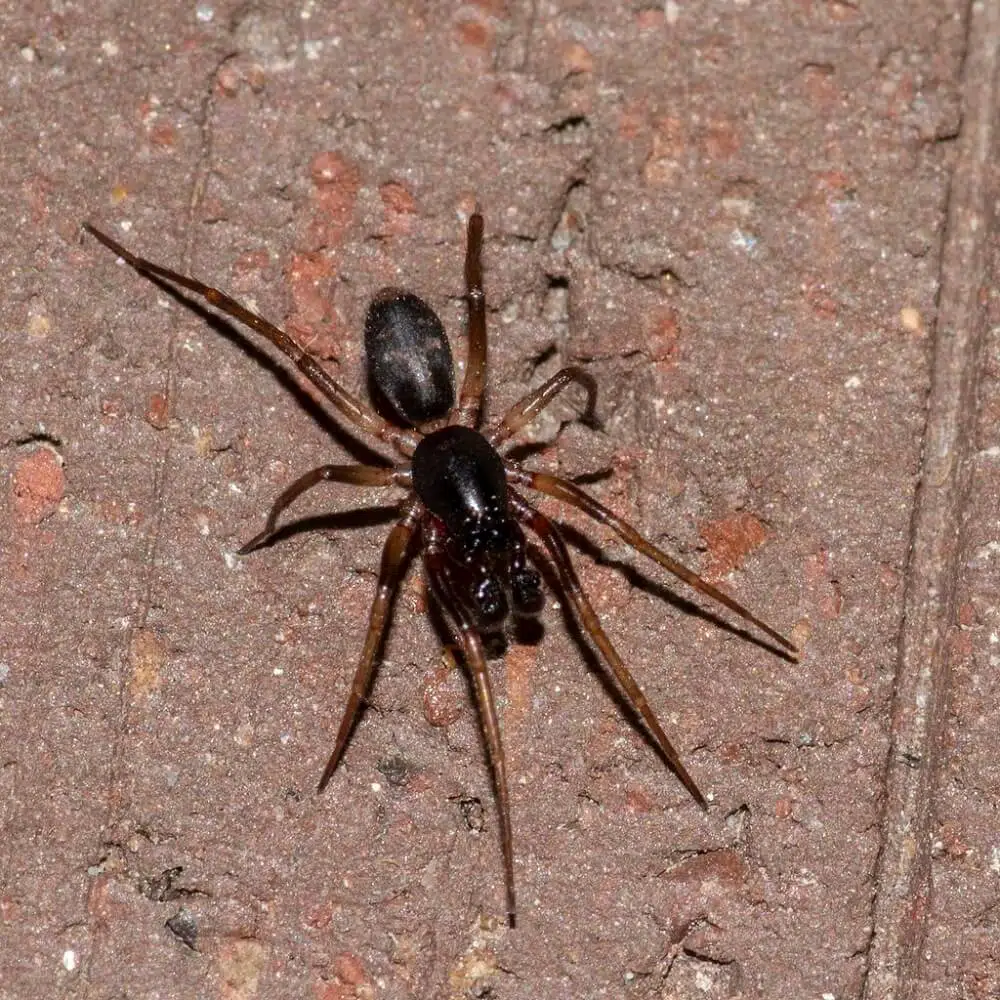
This multi-colored spider originates in South America. It features black, tan, red, and brown coloring. However, most of the body is black for this species.
Part of the Falconina genus, the spider is known for having a dark brown and black body. Its legs are tan.
Males have more black coloring on their bodies compared to females, but they’re also smaller. Male spiders can measure up to 6.4mm while females can measure up to 8.9mm.
Black Spiders With White Spots or Stripes
1. Bold Jumping Spider

The Bold Jumping Spider (Phidippus audax) is common in the US, particularly in Florida. It grows to an average adult body size of 11mm and it’s known for a black body and short thick black legs.
Part of the Phidippus genus, these spiders have white markings on their abdomen which can also be yellow or even red depending on where they live and depending on their age.
2. Zebra Jumping Spider

The Zebra Jumping Spider (Salticus scenicus) is known for its black and white body coloring as its name suggests.
This spider grows to body size of up to 11mm in the case of females, which are larger than males.
Apart from their vivid black and white coloration, these spiders also have very large eyes. Most jumping spiders are known for having an excellent vision.
3. Twin-flagged Jumping Spider

These spiders (Anasaitis canosa) are common around the house as well as around other man-made structures such as barns and garages.
Black dominates the body of these species. They also have white and brown markings, particularly on the abdomen. The legs of these spiders are mostly brown, with just a few black hairs.
4. Bronze Jumping Spider

The Bronze Jumping Spider (Eris militaris) is known for its hairy body. These are small spiders with a body length anywhere between 5 and 7mm.
Short gray and black hairs dominate the appearance of the species both on the body and on the legs. Some spiders of the genus can also have pale yellow hairs.
5. Flea Jumping Spider

Black and gray hairs distinguish Flea Jumping spiders (Naphrys pulex).
These hairs are seen on their cephalothorax, abdomen, and legs. Orange hairs are also found on the cephalothorax of the male Flea Jumping spider.
6. Buttonhook Leaf-beetle Jumping Spider

This species (Sassacus vitis) is known for its mostly black body and dark gray legs. It has a black cephalothorax. Its first couple of legs are also black. The rest of its body is grey.
The species can be further identified by a thin white line that contours the cephalothorax and the abdomen.
Both males and females of the species can also be easily identified by their small size. They rarely grow larger than 5mm.
7. Coppered White-cheeked Jumping Spider

This spider (Pelegrina aeneola) is only known for having a black carapace. It has a dark gray/brown abdomen and light brown legs.
Its hairy legs and abdomen look different from its black carapace is mostly made of very short black hairs.
8. Long-palped Ant-mimic Sac Spider

This spider (Castianeira longipalpa) is known for its black and gray body. It has a black thorax, black abdomen, and black legs, all with white markings and stripes.
With its long legs, this spider is also known for having 4 brown front legs while the 4 back legs are black.
Black Spiders With Red Spots
1. Black Widow

Black Widows are some of the most dangerous black and red spiders. Known for their painful sting, these spiders have slender figures with black bodies and black legs.
Some Black Widows have a red hourglass marking on the abdomen. Other Black Widows only have red marks on the abdomen.
Red and white markings on the abdomen are also common on some Black Widows.
These spiders can further be identified by the size of their body. A male Black Widow grows to a size between 3 and 10mm while females can grow up to 13mm.
Further Reading:
2. Red-spotted Ant-mimic Sac Spider

This spider (Castianeira descripta) mimics ants to approach prey easily. It can be recognized by its black body and red abdomen.
Some Red-spotted Ant-mimic Sac Spiders also have a white line on the carapace.
3. Johnson’s Jumping Spider

This common US spider (Phidippus johnsoni) has a mostly black body. Its head is black, and its cephalothorax is black. Its legs are also black but with fine white hairs.
Striking red abdomen coloration also characterizes the species. Males have an all-red abdomen (while the rest of the body is black). Females have a red abdomen with a central black stripe which helps clear species gender identification.
4. Brilliant Jumping Spider

The Male Brilliant Jumping Spider (Phidippus clarus) has a black body with a red abdomen that has a black line in the middle. It features all-black legs as well.
The female of the species isn’t black and barely resembles the male. It has the same red abdomen with black markings but the rest of the body is brown or brown/gray.
5. Grayish Jumping Spider

This jumping spider (Phidippus princeps) is one of the species where the male looks completely different from the female.
It’s only the male Grayish Jumping Spider that’s black while the female is gray.
The male spider is mostly black with a red abdomen. Its legs are also black and some adult males also exhibit small black marks on their red abdomens.
6. Whitman’s Jumping Spider

There are considerable differences in how the Whitman’s Jumping spider (Phidippus whitmani) looks from males to females.
Most females are known for having a gray color with a red carapace and a red abdomen.
There’s no gray body part on the male. Instead, it has a black body with a red thorax and a red abdomen. Its legs are light brown.
7. Cardinal Jumping Spider

This spider (Phidippus cardinalis) is known to mimic the Multilidae wasp. It has the same color for defense purposes.
The Cardinal Jumping Spider is black with a red carapace and a red abdomen.
Its legs are short and thick, also of black color. Some people know this species by its very painful sting.
8. Apache Jumping Spider

This species (Phidippus apacheanus) is known for living in tall grass even at high altitudes. It stands out immediately as it has black and red coloring.
These spiders are common in the US. They aren’t known for spinning webs. Instead, they build tent-like structures out of silk which acts as shelter.
While seen on ground level, these structures do not completely hide these spiders as their red markings on the thorax and abdomen make them stand out even if the rest of the body is black.
Further Reading: